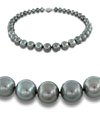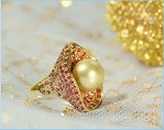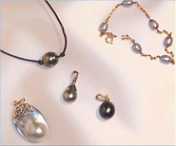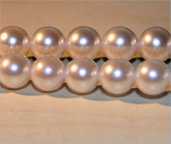|
The Feel-Good Guide to Sports, Travel, Shopping & Entertainment
|
| Main | Sports Events | Holidays & Observances | Pop Culture | Shopping | Travel |
|
MAIN
Buying Cultured Pearls What do all these mean? In order to make the best decision when buying pearls, it is important to know the differences between these type of pearls and why some are more expensive than others. Listed here are the different types of cultured pearls and how they are cultured. South Sea Pearls
South
Sea pearls are primarily cultured in the waters of Australia,
the Philippines and Indonesia. Some will mistakenly include pearls
found from the waters of Tahiti and French Polynesia and call
them Black South Sea Pearls. The gold-lipped pearl oyster used to culture these pearls (Pinctada maxima) is the world's largest pearl mother and is considered by experts to produce the best pearls in the world. The sizes of the pearls produced range in size from 10 to 20 millimeters, though pearls larger than 16 millimeters are rare. Their rarity and exceptional sizes make them highly prized. These are some of the largest and most expensive pearls available.
Tahitian Pearls or Black South Sea Pearls Sometimes referred to as Black South Sea Pearls, Tahitian pearls are cultured in areas stretching from the Cook Islands, eastward through Tahiti to the Tuamotu Archipelago and the Gambier Islands in French Polynesia. The are grown in the black-lipped pearl oyster (Pinctada margaritifera) found in the atolls of these areas. The colors produced vary widely from purple, green, black and shades from gray to cream and even white. The rarest and highly sought after color is peacock green - the greenish black color of a peacock feather. Black Tahitian pearls are generally smaller than the White South Sea Pearls ranging in size from 7 to 15 millimeters. Akoya or Japanese Pearls
Probably the
most well known name of a pearl type from the Akoya
oyster (Pinctada fucata martensil). Most akoya pearls are
still produced in Japan but now some are also grown on an increasing
scale in China and India. Considered the classic amongst cultured pearls, Akoya Pearls are primarily round or oval in shape and are produced in white and cream shades with silver or pink overtones. Freshwater Pearls Freshwater pearls are small, sometimes irregularly shaped pearls that are grown in various species of freshwater mussel. The colors range from pink, gray or black, bronze, lavender, to white. Natural freshwater pearls occur in mussels for the same reason that saltwater pearls
occur in oysters. Foreign material, usually a sharp object or parasite, enters a mussel and cannot be expelled. To reduce irritation,
the mollusk coats the intruder with the same secretion it uses for shell-building, To culture freshwater pearls, the shell of the mussels are slightly opened, small slits are cut into the mantle tissue and small pieces of live tissue from another mussel is inserted into those slits. The shape of the nucleus and its position in the mussel determines
the shape of the cultured pearl. The shapes recovered include rounds, pears, eggs, drops, buttons, dome, and baroques. Most The pearls are nursed for up to three years to achieve their luster and quality, a distinct trademark of our Cultured pearls and Freshwater pearls. also see-> Buying Pearl Jewelry | Jewelry Buying Advice About the Author... This article was provided by Pearls by Angela Carol.
|
 When
buying pearls, the customer is presented with terminology they
are not always familiar with -
When
buying pearls, the customer is presented with terminology they
are not always familiar with - 



